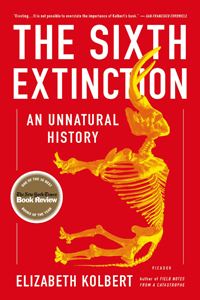 Elizabeth Kolbert, The Sixth Extinction; An Unnatural History (New York: Henry Holt, 2014), 319pp.
Elizabeth Kolbert, The Sixth Extinction; An Unnatural History (New York: Henry Holt, 2014), 319pp.
By Dan Clendenin
As I finished Elizabeth Kolbert's second best seller book (cf. Field Notes From a Catastrophe, 2006), I read a news item about scientists who are drilling 5,000 feet below the surface of the Chicxulub Crater in Mexico in order to obtain a core sample. About 65 million years ago, a giant asteroid slammed into the Yucatan Peninsula, leaving a 125-mile-wide crater. That "mass extinction event" wiped out the world's non-avian dinosaurs.
Kolbert explores the "Big Five" mass extinctions in the history of the earth, when an abnormally high number of species died in a short period of time. The causes of these mass extinctions have been varied and debated — glaciation, ocean chemistry, volcanic eruptions, asteroids like the one that hit Mexico, etc. In the Permian extinction 250 million years ago, the greatest extinction event ever, 96% of species died out. Kolbert explains why many scientists believe that we have already entered a sixth mass extinction event, one with two ominous distinctions. First, the rate of extinction is significantly faster than the normal "background" rate. Second, human activity is the cause.
Kolbert hedges her bet, saying that "it's still too early to say whether it will reach the proportions of the Big Five." Each of her thirteen chapters tracks the fate of a single species that she construes as "emblematic" of the sixth extinction. She reports from places as varied as rain forests in Brazil, coral reefs in Australia, bat caves in the northeastern United States, and a zoo in Cincinnati — home of one of the last Sumatran rhinos and one of many "captive breeding programs." If humanity is the agent of the Sixth Extinction — with our pollution, invasive species, fossil fuels, habitat destruction, over-harvesting, population growth, climate change, etc., the ominous question at the end of her book is whether humanity will also be one of its victims.


